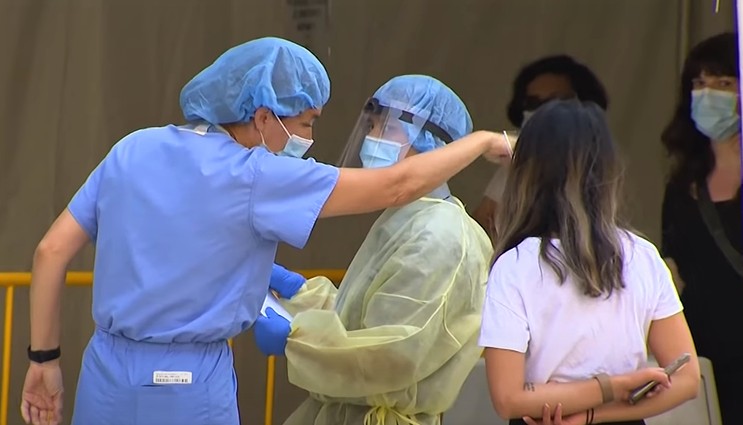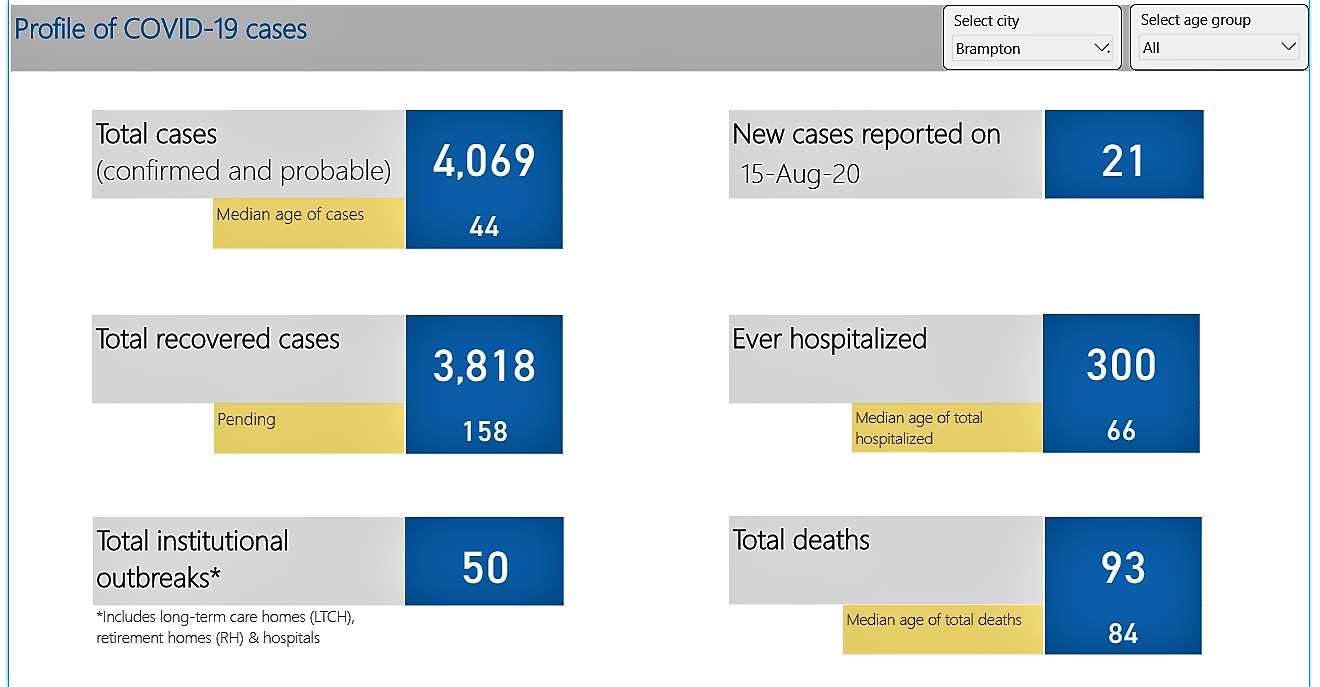
Brampton’s COVID cases rising in Stage 3 with almost 20% of Ontario’s infections over the past week
Brampton is once again having problems with its COVID-19 case numbers, after Peel Region entered into Stage 3 of Ontario’s reopening strategy on July 31. Mississauga has seen its numbers stay consistently low, unlike its neighbour to the north.
On August 3, Brampton reported just four cases of COVID-19, continuing a trend of slightly declining infection numbers for the previous four days, leading into the city’s entry into Stage 3. Since those four cases, numbers have been increasing, from five on August 4 to 21 on August 15. From August 9 to August 15, the average number of cases in Brampton over the seven days was 15.7, compared with an average of 8.9 cases a day the week prior. Infections in the city almost doubled in the past week. Brampton now accounts for almost 56 percent of all cases reported in Peel since the beginning of the pandemic.

Brampton's daily COVID-19 case counts
Mississauga, meanwhile, has accounted for 41 percent of all Peel cases and continues to show progress as numbers have remained consistently low for about a month. The region’s largest municipality only reported an average of 3.29 cases in the seven days from August 9 to August 15. When using per capita infection rates, Mississauga had less than one fifth the number of cases over the past week, compared to Brampton.
It’s unclear why the infection numbers in Peel’s second largest city are spiking while cases across most of Ontario have been on the decline. Over the same seven-day period, from August 9 to August 15, Ontario reported 598 cases, so Brampton had 18.4 percent of the province’s cases over this seven day period, despite only making up about 4.5 percent of the province’s population (based on 650,000 residents in the city).

Mississauga's daily COVID-19 case counts
The city’s demographics could be a factor.
Throughout April 13 to July 15 there were 3,880 cases of COVID in Peel. Visible minorities make up 63 percent of Peel’s population but accounted for 77 percent of the cases, according to data released by the Region of Peel.
But in Brampton, visible minorities make up a higher portion of the overall population, 73 percent as of the Census taken in 2015 and likely higher now. The high rates of COVID-19 among South Asian-Canadians could be another factor, as a large segment of the city’s population identifies as originating from the subcontinent.
South Asian-Canadians make up 31.6 percent of the overall Peel population but accounted for 45.1 percent of the COVID cases between April 13 and July 15, according to the data from the Region.
In contrast, 36.8 percent of Peel’s population identify as white but they only accounted for 22.6 percent of the COVID-19 cases during the same period. The white population in Brampton, according to the last Census, only accounted for about 26 percent of the city’s residents and, again, that number is likely even lower now. Populations that have been hit harder by the virus are overrepresented in the city, compared to Peel overall.
Employment could also play a role.
The data collected shows those who worked in a higher risk environment or couldn’t work from home were more likely to contract the virus.
Experts around the world have pointed to similar data, as immigrant populations that have not yet secured an economic footing in regions across numerous countries have contracted the virus at much higher rates than the rest of the population in their jurisdiction. On top of the inability to work from home and the need to perform essential labour, the lower socioeconomic reality is correlated with living conditions that are often more dense, with many more people per square kilometre in such neighbourhoods.
Higher risk jobs were deemed essential throughout the pandemic; examples are those in healthcare, grocery store workers, transportation, sanitary workers and factory jobs like the food industry.
Between March 5 and July 15 there were 5,652 positive cases of people aged 15 or older in Peel. Of these, 2,933 (52%) reported their occupation. Each case was categorized by different industries using the National Occupational Classification system.
The highest risk occupation which accounted for 33.3 percent of COVID-19 cases in Peel during this period worked in the health industry. In Peel, the industry only accounts for 5.1 percent of those in the workforce, meaning residents employed in settings such as hospitals were vastly overrepresented in Peel’s overall case counts.
Those in trades, transport and equipment operators make up 15.6 percent of Peel’s population and 17.9 percent of the COVID cases. A large part of Peel’s workforce is employed in sales and services, 23.4 percent of the total labour base, but only accounted for 12.9 percent of the total cases.
Jobs that allowed most employees to work from home made up a much smaller portion of the COVID cases in the Region. Those in education, law, social and community work, government and management positions represented only 8.9 percent of the cases, but they make up 19 percent of the total population.

Cases in Brampton (institutional outbreaks are for all of Peel)
Brampton has also been criticized for enforcing strict penalties for violating safety measures with fines as high as $100,000 allowed in the city. Mississauga has taken more of an educational approach, determining that being too harsh will only make it more difficult to track and trace possible infections. For example, when a house party in Brampton last month blatantly violated safety guidelines, with some 200 people in attendance, health officials would have had a hard time tracing any possible infections to the event, and possible community spread as a result, because people likely would not have cooperated for fear of harsh punishment.
Dense family dwelling arrangements in Brampton have also been pointed to by Peel Public Health; the city has the largest average number of residents per household in Ontario.
Low testing numbers in Brampton since the start of the pandemic have also been blamed for the city’s high infection rate. Despite a population of about 650,000 it has only maintained one testing site since the beginning of the pandemic and the province has had to send in emergency help, setting up pop-up screening facilities to boost testing. Etobicoke, with a little more than half Brampton’s population has maintained two sites while Mississauga also has two screening locations.
The fear now, with restaurants and bars having opened two weeks ago, along with other facilities under Stage 3, is that numbers in Brampton could get even worse, as students across the city prepare to go back into classrooms in September.
Email: [email protected]
Twitter: @JoeljWittnebel
COVID-19 is impacting all Canadians. At a time when vital public information is needed by everyone, The Pointer has taken down our paywall on all stories relating to the pandemic and those of public interest to ensure every resident of Brampton and Mississauga has access to the facts. For those who are able, we encourage you to consider a subscription. This will help us report on important public interest issues the community needs to know about now more than ever. You can register for a 30-day free trial HERE. Thereafter, The Pointer will charge $10 a month and you can cancel any time right on the website. Thank you.
Submit a correction about this story


